Rava Laddu is a quick and easy South Indian traditional sweet that's vegan, and ready in just 30 minutes! Made with semolina (sooji/rava), sugar, vegan ghee, cashews, and fragrant cardamom, this easy Rava Laddu recipe is a delicious festive treat. Often prepared during Diwali or the winter season, these melt-in-your-mouth Rawa Ladoos are a must-try Indian dessert that's both simple and indulgent.
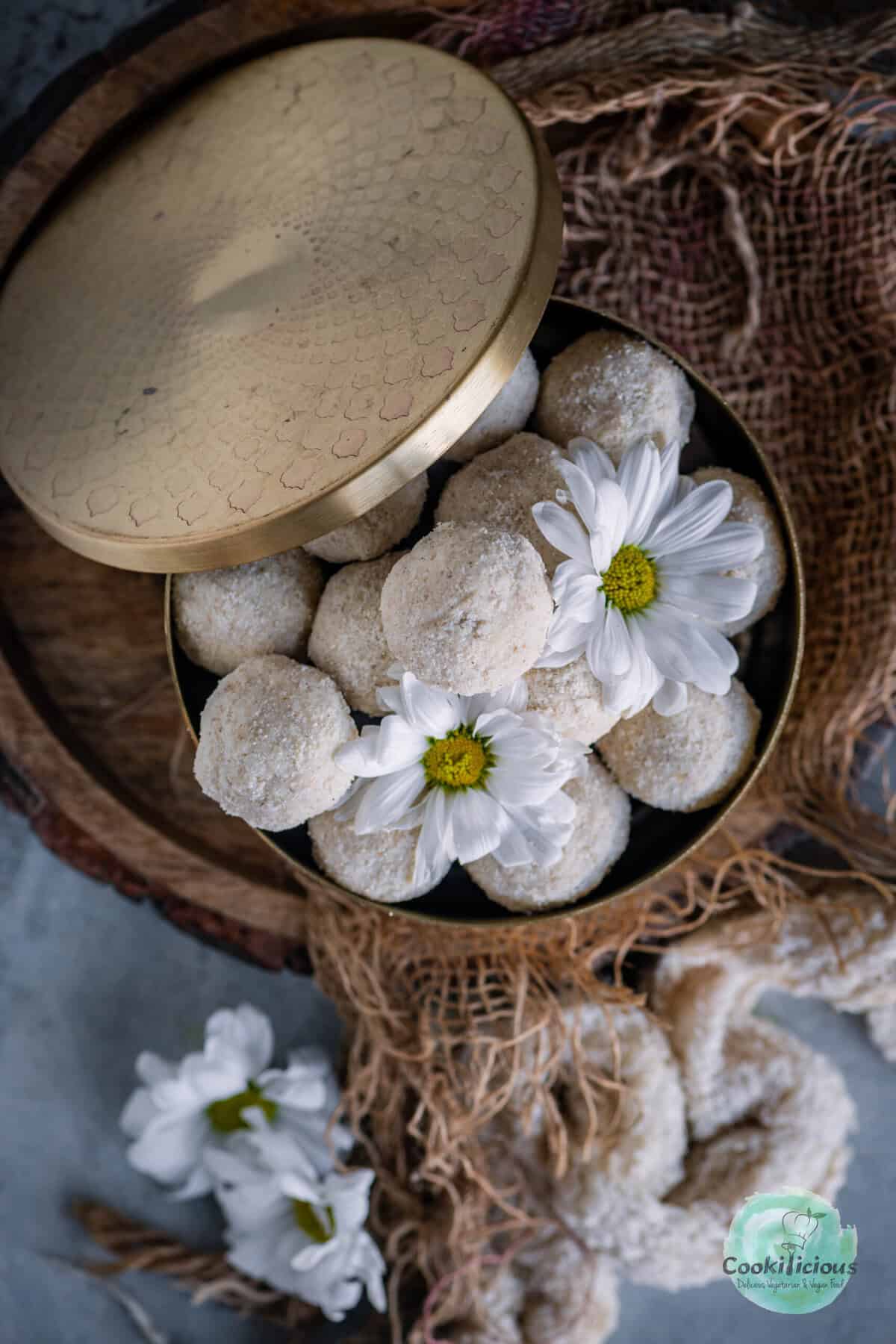
Jump to:
What is Rava Laddu
Rava Laddu, also called Rava Ladoo, Rawa Laddu, Rawa Ladoo, Suji ke Laddu, Sooji Ladoo, Rava Urundai, Ravechi Ladoo, or Rava Unde in South India, is one of the most beloved and traditional Indian sweets.
The word Rava refers to semolina (also called rawa or suji), and Laddu (or Ladoo) means a ball-shaped sweet made with various ingredients. This traditional sweet suji ladoo recipe is often prepared during festivals, pujas, and special occasions. Rava ke Ladoo is one of the oldest mithai in Indian households, cherished across generations.
In Tamil homes, Rava Laddu is also known as Rava Urundai, while in Karnataka, it is fondly called Rava Unde.
Some other popular ladoo recipes you can try from the blog are Vegan Coconut Laddus, Rose Coconut Laddus, and even Coconut Macaroons, which are quite similar to traditional Indian laddus.
When is Rava Ladoo Made
Rava Laddu is a classic Indian sweet that takes center stage during festivals like Diwali, Ganesh Chaturthi, and Janmashtami. This traditional Rava Laddu recipe is not only aromatic and delicious but also has a melt-in-the-mouth texture with just the right amount of crunch. Perfect for festive sweet platters or as homemade Diwali gifts, these easy laddus are truly the embodiment of a celebratory Indian dessert.
also made in the winter season since semolina generates warmth in the body. Traditionally, families would prepare large batches of Rava Laddus to last the entire winter season and to share with joint families. Just like Carrot Halwa (Gajar ka Halwa), another classic Indian winter dessert, Rawa ke Laddu is comforting, wholesome, and nostalgic.
A Personal Memory
Every Diwali, Mom would make Rava Laddus, and as a child, I loved being assigned the fun task of shaping them into perfect little balls. It was always my favorite part! Since we were kids, none of the laddus were the same size, but my mom never worried about perfection. Instead, she let us create happy memories in the kitchen without pressure or negativity.
For me, making Rava Laddu will always mean more than preparing a South Indian sweet-it's about reliving childhood memories and celebrating the love that goes into homemade Indian desserts. That's why this Rava Laddu recipe for Diwali holds such a special place in my heart.
Why Make It
- ✨ This Rava Laddu recipe is made without milk, coconut, sugar syrup, or condensed milk - and uses vegan ghee for a plant-based twist!
- 🌱 A vegan, Tamil-style festive dessert
- 🥄 Made with just 5 simple ingredients
- ⏱️ Quick and easy - ready in 30 minutes
- 💯 No-fail, beginner-friendly suji ladoo recipe perfect for festivals and celebrations
🧾 Ingredients Needed
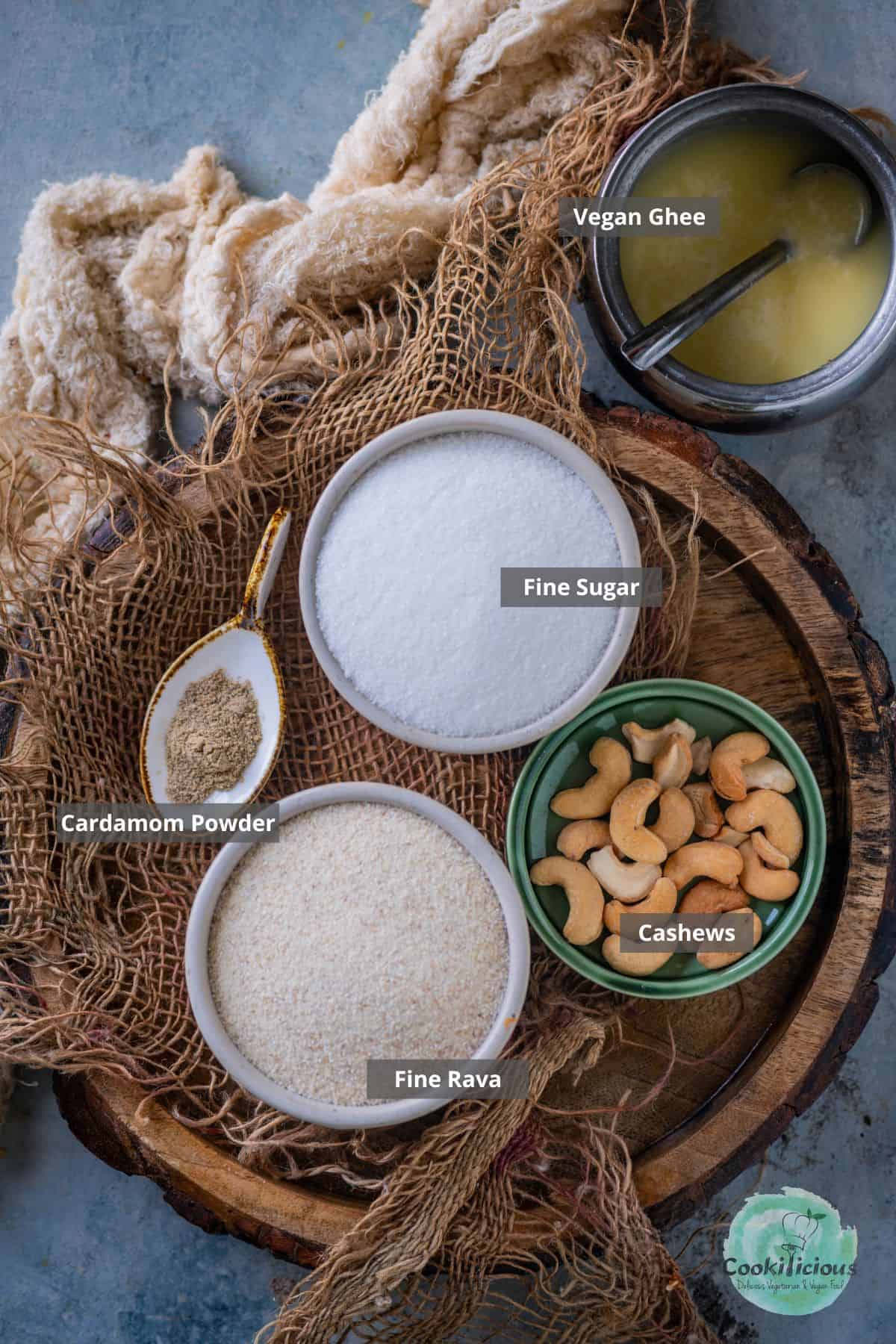
Semolina (Rava/Sooji/Suji/Broken Wheat):
I used fine rava for this Rava Laddu recipe, but you can also use regular rava, since it will be ground into a smooth mixture eventually. Pre-roasted rava from Indian grocery stores saves time, Bombay rava and chiroti rava (extra fine semolina) makes the softest, melt-in-your-mouth Rava Laddu.
💡Did you know? Apart from making melt-in-your-mouth Rawa Laddu, you can also use semolina to prepare other South Indian favorites like Sheera, Rawa Dosa and Rawa Idli. It's a versatile ingredient that can be used in both savory and sweet recipes.
Sweetener (Sugar):
White sugar works best for perfect texture and color. Avoid icing sugar as it changes the flavor. Condensed milk can be used for variation, but traditionally suji ke laddu is made using plain white sugar.
Cardamom:
An essential spice in most Indian sweets, cardamom gives Sooji Ladoo their signature aroma. Use freshly crushed pods or store-bought powder.
Nuts:
In my Tamil -style Rava Ladoo recipe, I always add roasted cashews for a rich, nutty flavor. Raisins can also be added for extra sweetness.
Ghee (or Vegan Ghee):
Traditional Rava ke Ladoo use pure ghee for richness. To make easy vegan Rava Ladoo, use good-quality vegan ghee or homemade dairy-free ghee.
How To Make It 🔪
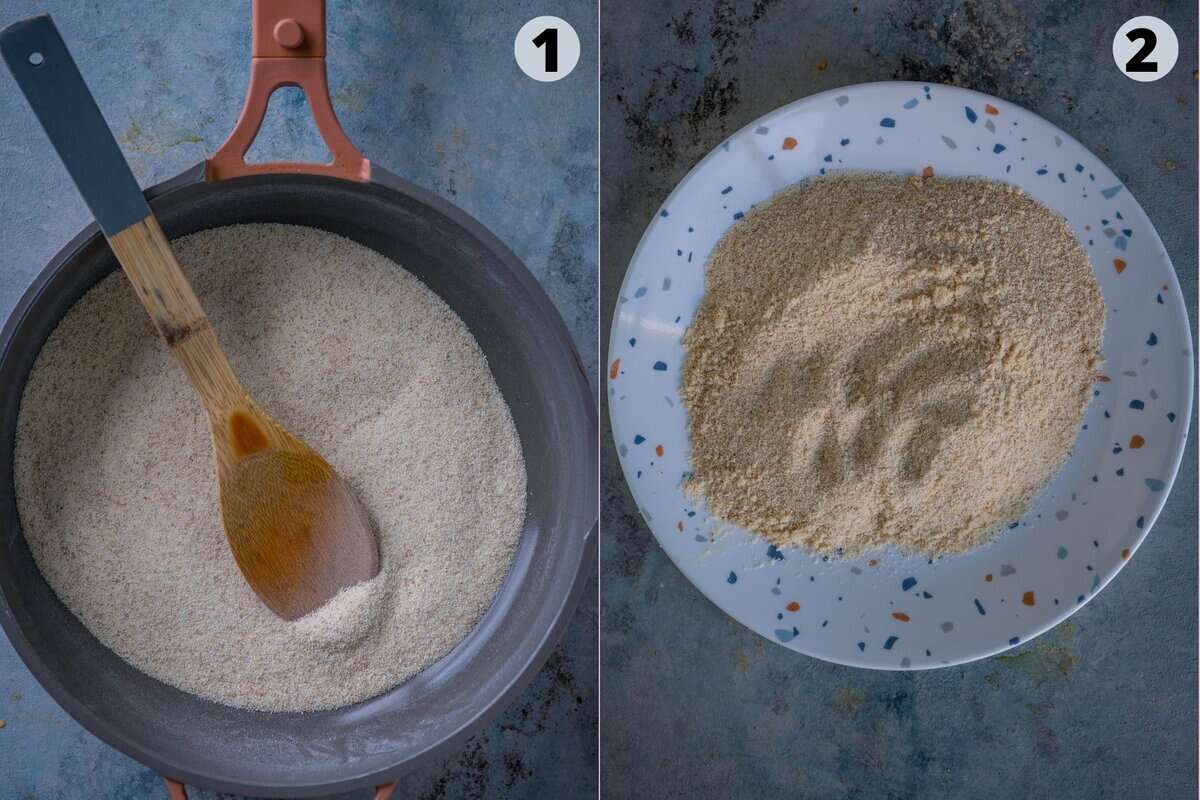
- In a pan, heat 1 teaspoon of vegan ghee on low-medium flame. Add sooji and roast for 2-3 minutes, stirring continuously. Roast until it releases a nutty aroma and slightly changes color. Be careful to not burn the suji.
- Immediately transfer to a plate to prevent overcooking.
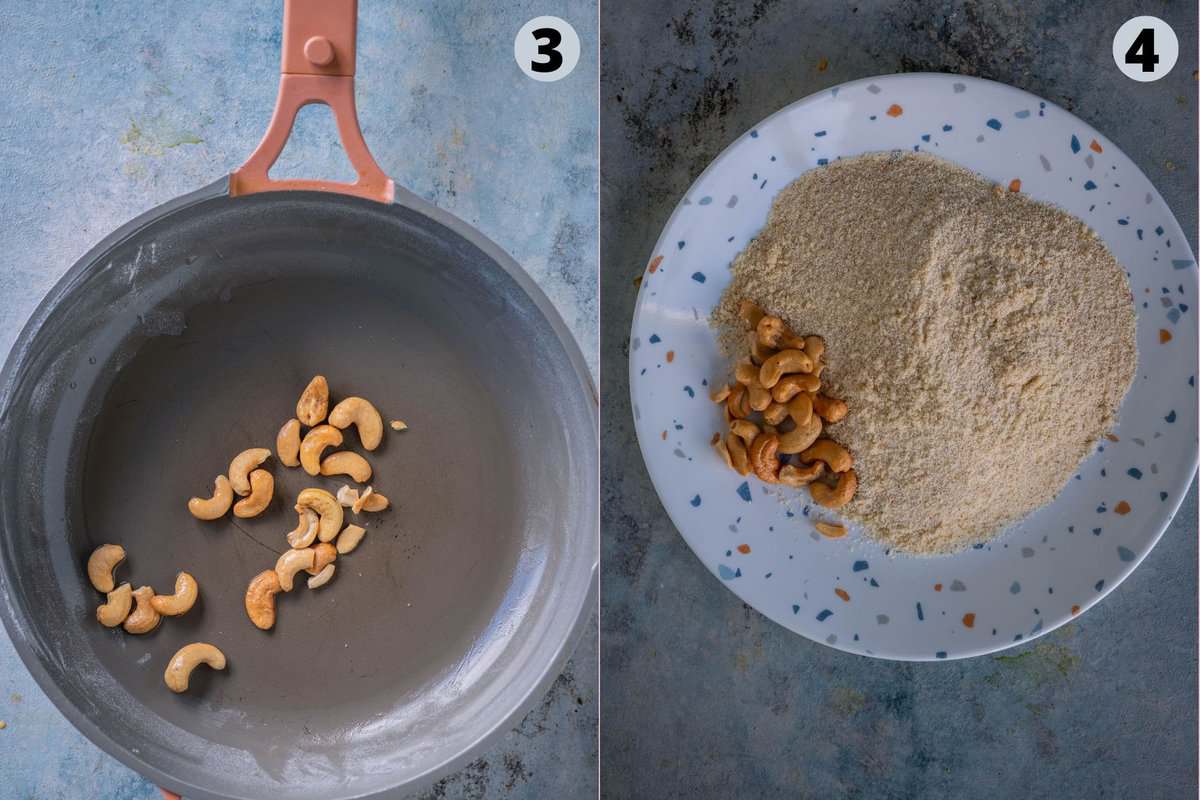
- In the same pan, add another teaspoon of vegan ghee and roast the cashews for 1 minute on medium flame. Be careful not to burn them.
- Transfer the roasted cashews to the plate with the semolina and allow the mixture to cool completely.
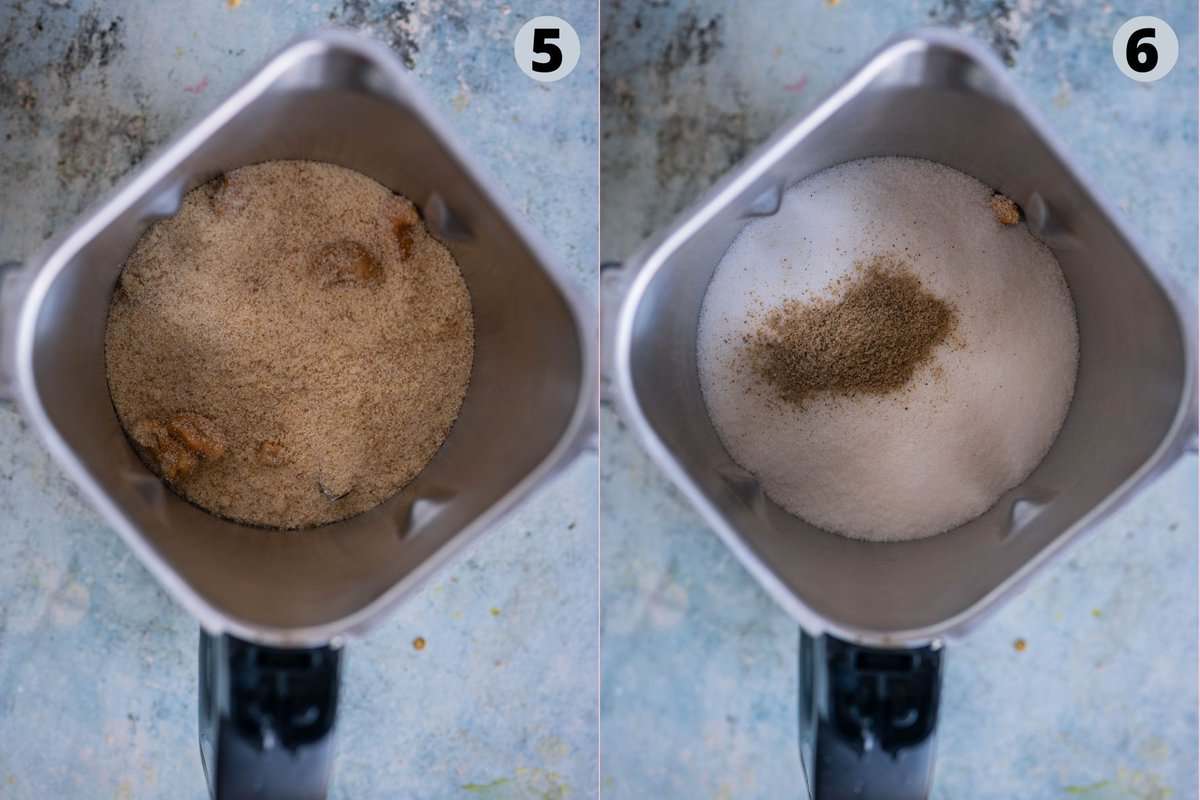
- Transfer the cooled roasted rawa and cashews to a dry blender jar.
- Add sugar and cardamom powder, and grind the laddu mixture to an almost smooth powder.
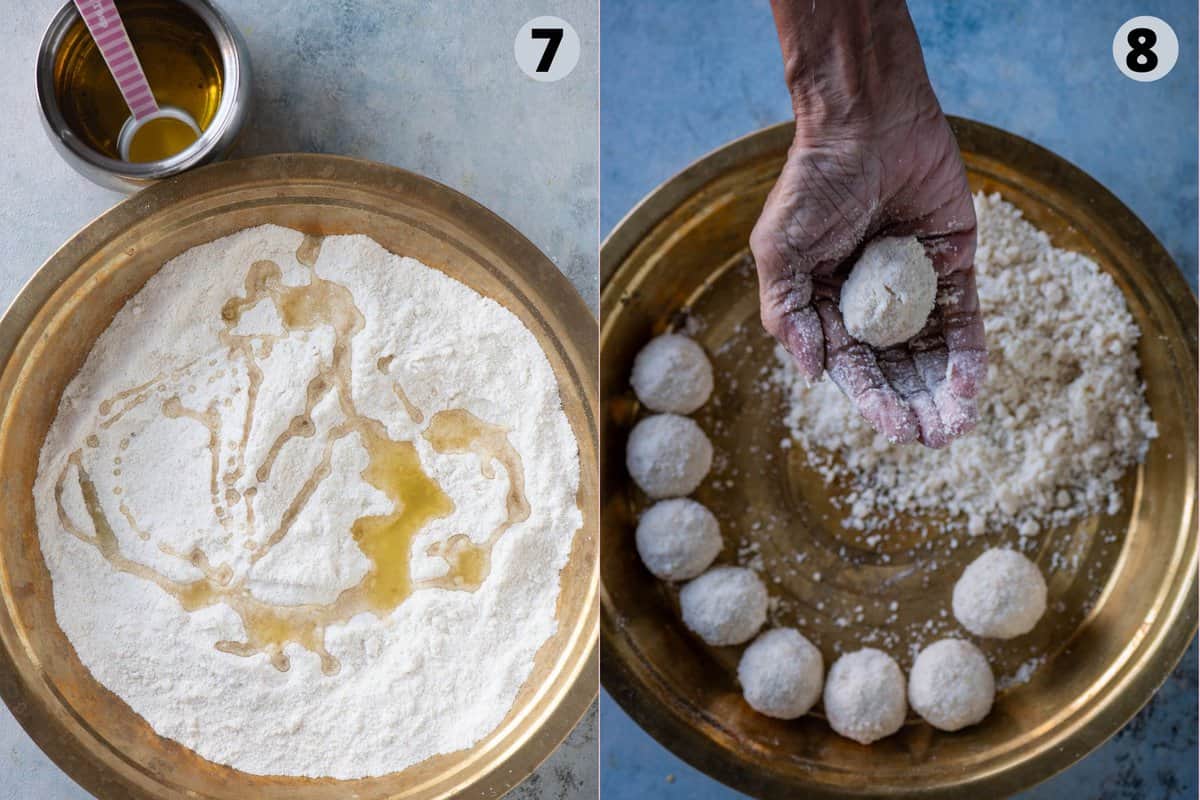
- Transfer back to a large plate. Chef Tip: Sieve the mixture if you want an extra-smooth texture. Taste and adjust sweetness by adding 1-2 tablespoons of powdered sugar if needed. Warm the remaining ghee and add 2 tablespoons to the mixture. Mix well and gradually add more ghee while combining. Warm ghee helps with the binding. It will resemble a crumbly mixture and not form a dough.
- Start making the ladoos immediately. Take a spoonful of the mixture and press firmly with your hands to shape medium lemon-sized Rava Laddus. Stop adding ghee once the mixture holds shape easily. I added a total of five tablespoons of ghee to make these Rava Laddus.

🍽 Serving Suggestions
Make as many Rava Laddus as needed and serve immediately. These Rava Ladoos are soft, nutty, and simply melt in your mouth! Store any leftovers in an airtight container for later consumption. Rava Laddu can be served during other festivals like Raksha Bandhan, Holi, Navratri, Sankranti, and any other puja/festival besides Diwali. I also serve it for Ganesh Chaturthi along with Steamed Modak or Chocolate Modak.
Serve Rawa Laddu as a tea or coffee time snack with other dry snacks like Sev, Boondi, Chiwda, Mathri, Thattai, or Chips. You can also this to the Indian Mithai Charcuterie Board.
💭 Priya's Recipe Tips
Grinding the cashews before adding them to the semolina ladoo mixture makes shaping the sweet laddus much easier, as the nuts don't come in the way. If you prefer, you can finely chop cashews and mix them in, but they may interfere while rolling the ladoos. You can also enhance the flavor of suji ladoo by adding raisins. Do not grind the raisins-simply fry them in a little ghee (or vegan ghee) until golden and then mix them into the ladoo mixture before shaping. If you feel the mentioned amount of sugar is less, you can add 1-2 extra tablespoons to adjust the sweetness.
FAQs 📖
For making Sooji Ladoo / Suji Laddu, I recommend using fine semolina as it gives the best texture. However, you can also use regular or Bombay rawa, since the mixture will be ground into a smooth consistency before shaping the laddus.
If you want a richer, melt-in-the-mouth taste, try using chiroti rava (extra fine semolina), which is often preferred for making soft Indian sweets. You may also come across pre-roasted semolina in Indian grocery stores, which can help save time. However, I still recommend lightly roasting it at home until it turns warm and fragrant to bring out the best flavor and aroma.
👉 Tip: Avoid using the dark roasted variety of rawa, as it alters both the color and flavor of the traditional white Rava ke Laddu.
You can also make these Rava Ladoos with ragi flour for a healthier twist. This variation adds a nutty flavor and makes the ladoos more wholesome, while still keeping them soft, melt-in-the-mouth, and festive-ready.
When making Suji Ke Ladoo, roasting the semolina properly is the most important step. If not roasted well, the laddus will taste raw and lack flavor. Here are some useful tips:
Choose good quality rawa - Always start with fine or medium semolina for the best texture in ladoos.
Roast on low flame - Heat a heavy-bottomed pan and dry roast the rawa over low flame. Stir continuously to ensure even roasting and to prevent it from burning.
Look for aroma and color - Roast the semolina until it releases a nutty fragrance and turns lightly golden brown. This usually takes a few minutes.
Notice the texture change - In the beginning, semolina feels heavy when stirred, but as it roasts, it becomes lighter and fluffier. That's when you know it's done.
Avoid under-roasting - If the sooji is not roasted enough, the ladoos will taste raw.
Optional shortcut - Pre-roasted semolina is available in many Indian grocery stores. However, I still recommend roasting it lightly at home until it's warm and aromatic for the best flavor.
Skip roasting? - Some people skip this step, but that gives a very different taste and texture, which most don't prefer.
Properly roasted sooji is what gives Suji Ladoo their signature flavor, aroma, and melt-in-the-mouth texture.
Getting the perfect Rava Ladoo comes down to a few key tips:
Choose the right semolina: The texture of the semolina matters. Avoid very coarse semolina-use fine or medium-grain semolina for the best ladoos.
Add hot ghee: Always pour warm to hot ghee into the roasted suji. This helps bind the ladoos and enhances the rich flavor.
Shaping the ladoos: Use your palms to shape the ladoos while the mixture is still slightly warm. First, press the mixture tightly with your fist until it binds, then gently roll it into smooth, medium-sized balls. The sweet laddus should hold their shape and not crumble easily.
Ensure even sizes: For consistency, use a cookie scoop or ice cream scoop to divide the mixture before rolling. This ensures you get evenly sized rava ladoos, which also look great when served.
Fixing the texture:
If the mixture feels too dry, sprinkle a little warm regular milk or coconut milk to moisten it. (Note: Adding milk will reduce the shelf life of the ladoos, so only use if consuming within 2-3 days.)
If the mixture is too loose, lightly roast some extra semolina and mix it in until the texture is right.
By following these tips, you'll get perfectly shaped, aromatic, and melt-in-the-mouth Rava Ladoos every time.
If you want to give your Rava Laddu a unique twist, here are some delicious ingredients you can add to the mixture:
Coconut Rava Laddu - Mix fresh or desiccated coconut with roasted semolina for extra richness and a nutty flavor.
Nutmeg or Saffron - A pinch of nutmeg or strands of saffron enhance the aroma and add warmth to the ladoos.
Chocolate Rava Laddu - Add a little white chocolate powder to the mixture for a fusion-style Chocolate Laddu. If you do this, remember to slightly reduce the sugar.
Rose Rava Laddu - Add a splash of rose syrup to the mixture for a fragrant and festive Rose flavored Laddu.
Other Flavors - You can also experiment with cardamom, vanilla, or even fruit syrups to create your own version of flavored Rava Laddus.
These easy variations make Rava Ladoo more versatile and perfect for festivals, parties, or gifting.
If your Suji Ladoos turn out hard, don't worry-it usually happens when:
-Not enough warm ghee is added.
-The mixture was allowed to cool too much before shaping.
Fix:
Sprinkle a little warm milk (or water, if keeping it vegan) over the mixture, mix well, and then reshape the ladoos.
Store these Indian laddus in an airtight container to prevent them from drying out further.
💡 Tip: Always shape the ladoos while the mixture is still slightly warm for best results.
To keep your Sooji Laddus fresh and delicious, store them in an airtight container or dabba at room temperature for 2-3 days. If you have prepared them using vegan ghee, it's best to consume them within 2-3 days for maximum freshness. However, if you've used regular ghee (desi ghee), these Indian sweet ladoos can last for up to a week at room temperature.
For longer shelf life, you can refrigerate Rawa Ladoos. Just make sure to bring them to room temperature before serving so they soften and taste as good as freshly made.
👉 Pro Tip: Always use a clean, dry hands when removing ladoos from the container to avoid moisture and spoilage.
More Festive Sweet Recipes
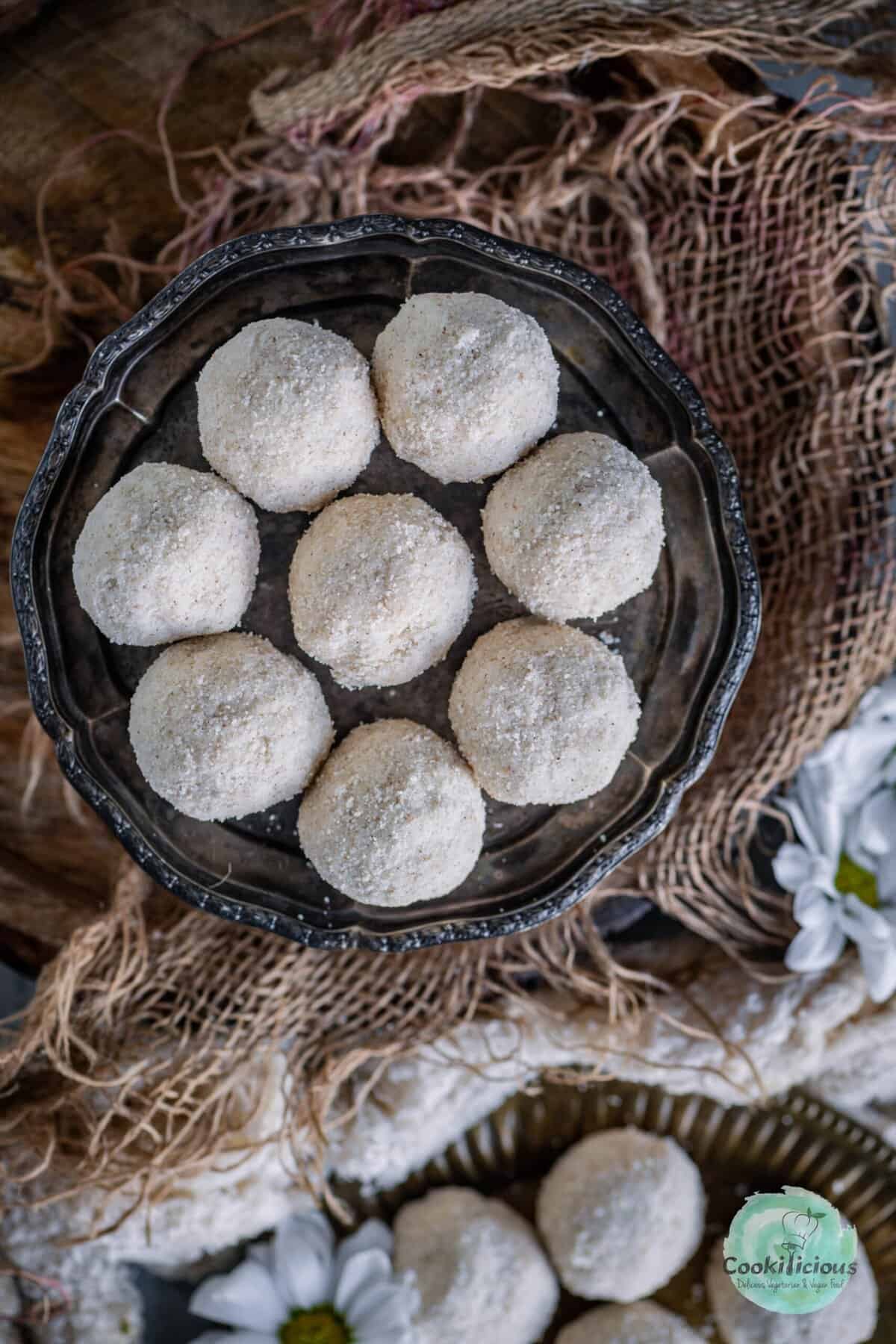
⭐️ Subscribe to the Cookilicious Newsletter and receive new recipes straight to your inbox! You'll receive my FREE Vegan Beginner's guide as a gift. Ready to elevate your cooking game? Purchase my Cookbook - The Essential Vegan Indian Cookbook today!
Recipe 📖

Rava Laddu Recipe (Rava Ladoo) - Easy & Delicious Indian Sweet
Equipment
Ingredients
- 2 tablespoon cashews
- 1 cup fine rava
- 1 cup fine sugar
- ½ teaspoon cardamom powder
- 6 tablespoon vegan ghee, warm
Instructions
- In a pan, heat 1 teaspoon of vegan ghee on low-medium flame. Add sooji and roast for 2-3 minutes, stirring continuously. Roast until it releases a nutty aroma and slightly changes color. Be careful to not burn the suji.
- Immediately transfer to a plate to prevent overcooking.
- In the same pan, add another teaspoon of vegan ghee and roast the cashews for 1 minute on medium flame. Be careful not to burn them.
- Transfer the roasted cashews to the plate with the semolina and allow the mixture to cool completely.
- Transfer the cooled roasted rawa and cashews to a dry blender jar.
- Add sugar and cardamom powder, and grind to an almost smooth powder.
- Transfer back to a large plate. Chef Tip: Sieve the mixture if you want an extra-smooth texture. Taste and adjust sweetness by adding 1-2 tablespoons of powdered sugar if needed. Warm the remaining ghee and add 2 tablespoons to the mixture. Mix well and gradually add more ghee while combining. Warm ghee helps with the binding. It will resemble a crumbly mixture and not form a dough.
- Start making the ladoos immediately. Take a spoonful of the mixture and press firmly with your hands to shape medium lemon-sized Rava Laddus. Stop adding ghee once the mixture holds shape easily. I added a total of five tablespoons of ghee to make these Rawa Ladoos. Make as many Rava Laddus as needed and serve immediately or store in an airtight container for later consumption.

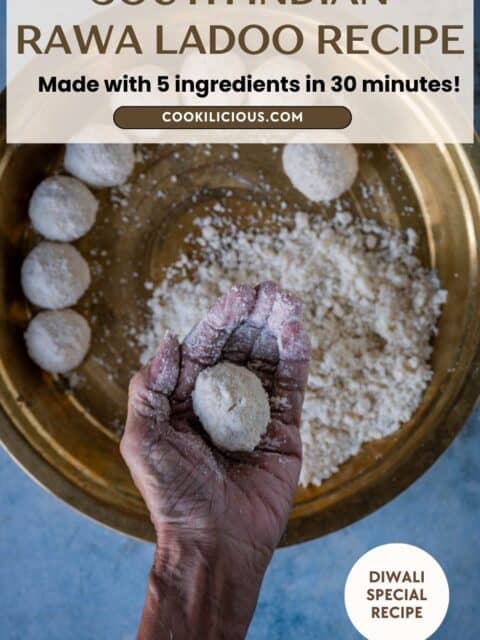
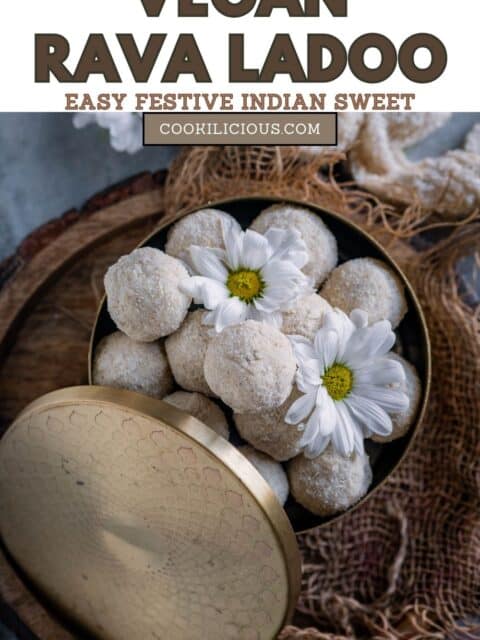
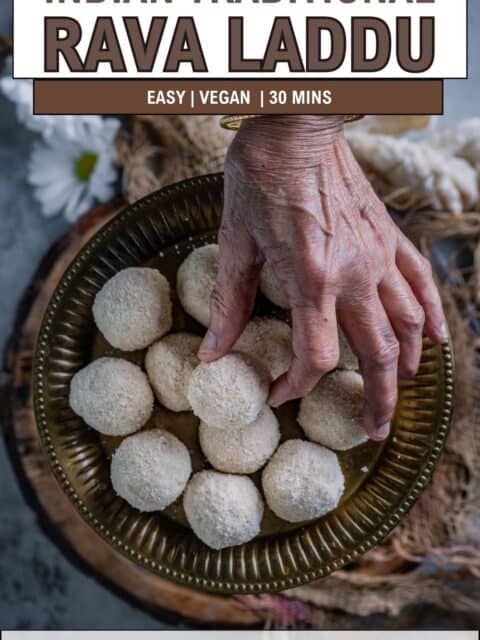
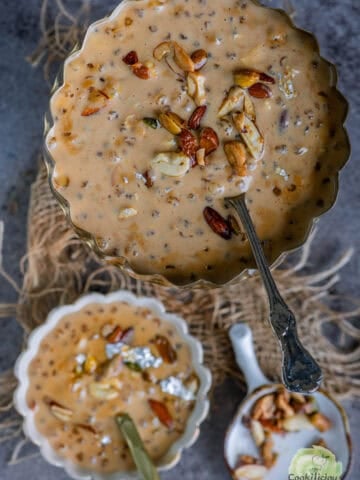
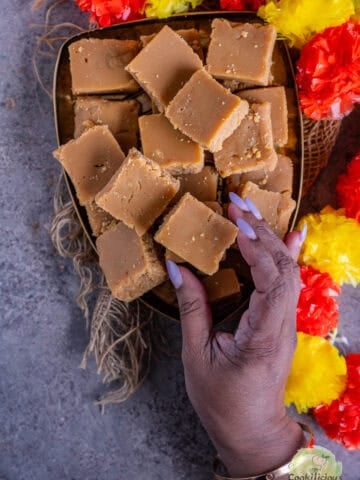
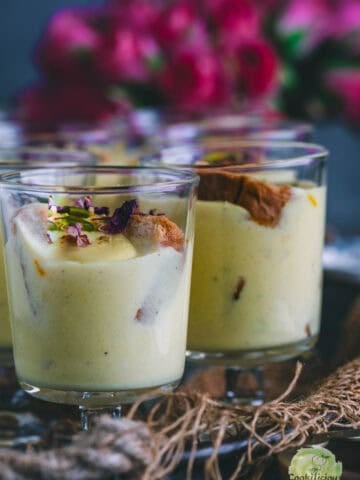
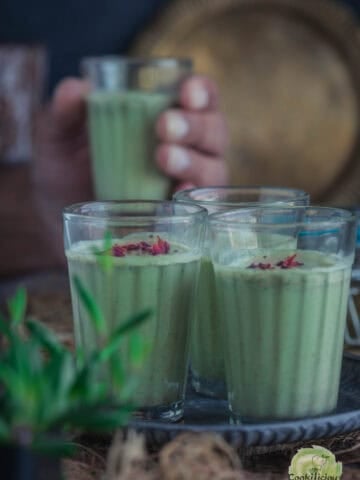

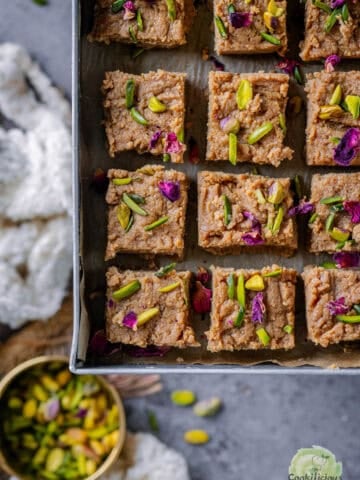
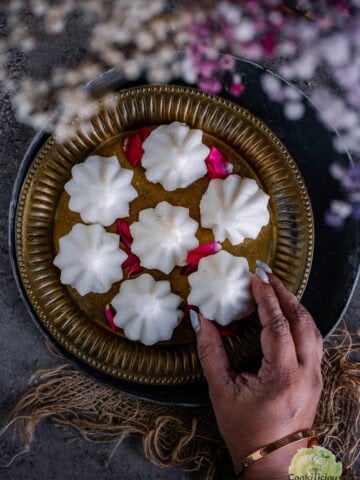

Teresa says
Sounds like a very interesting recipe, and I may need to try it with the cashews too. Thank you for sharing at The Really Crafty Link Party. Pinned!